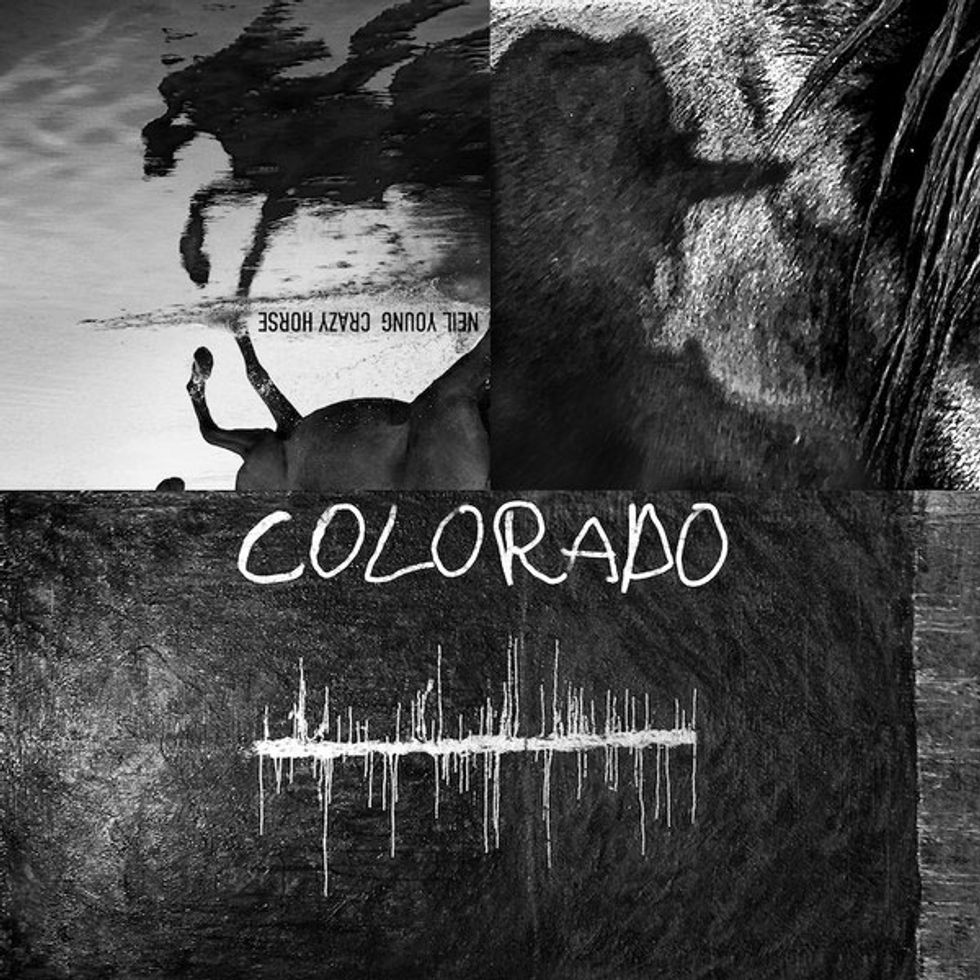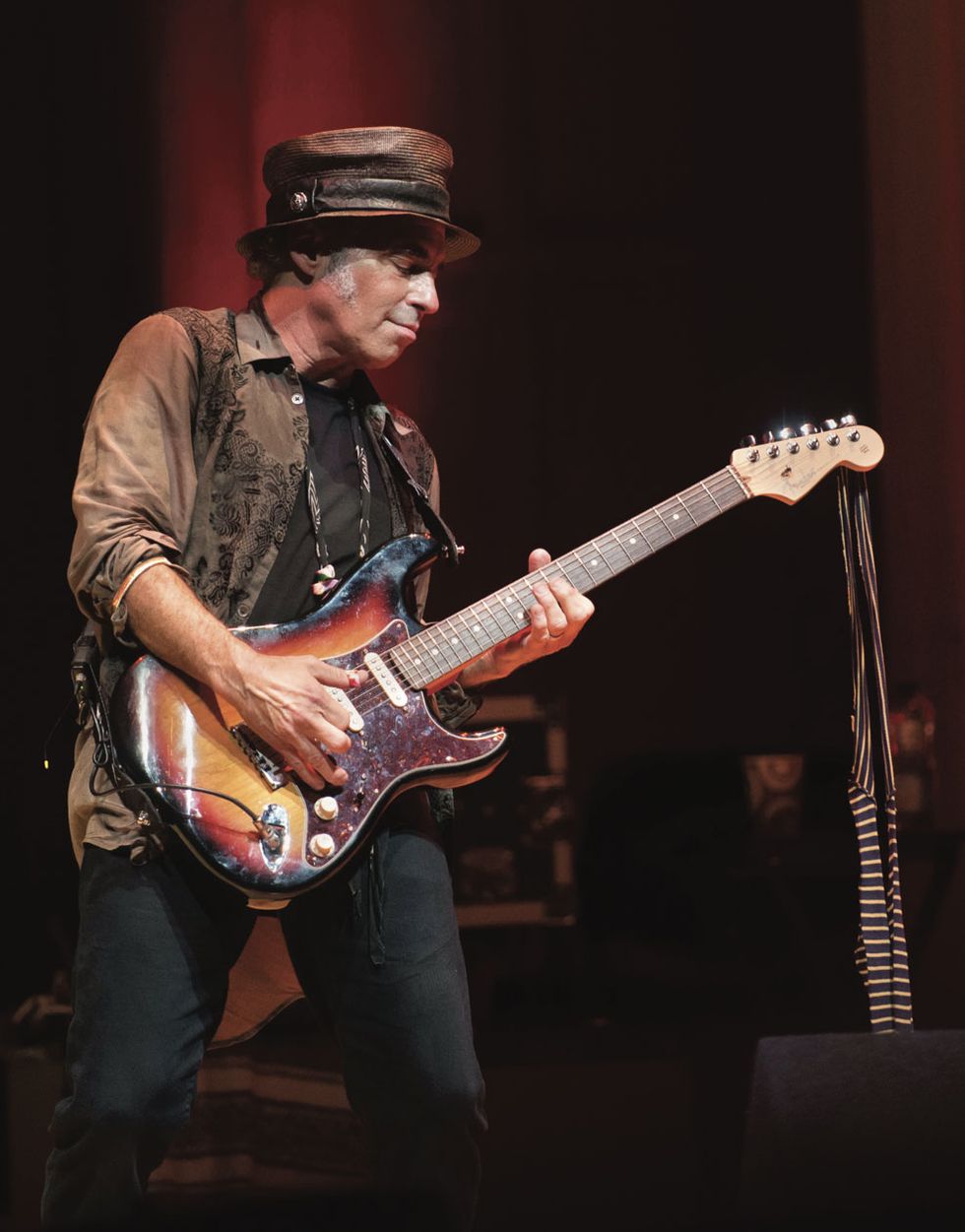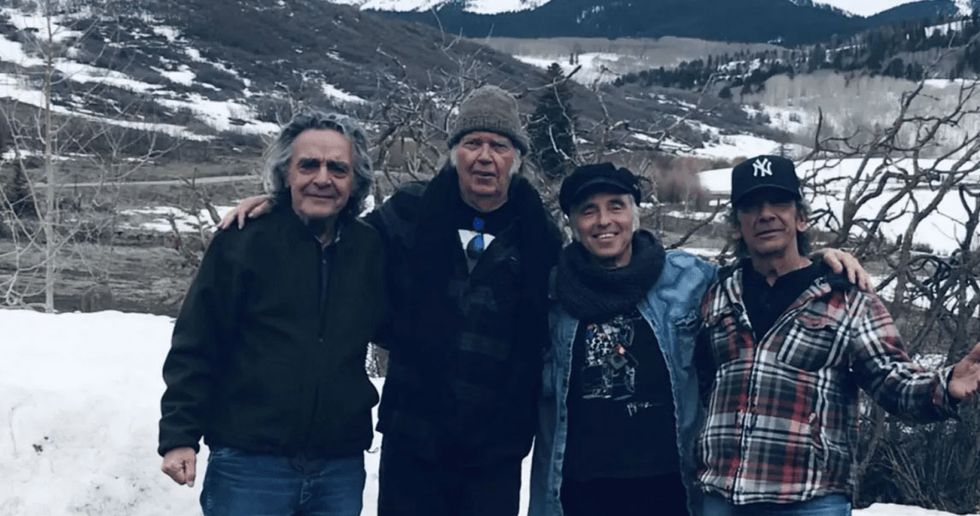Much like a well-played vintage instrument, a great improvising band just gets better with age. The depth of an ensemble’s improvisational abilities grows as the musicians become more comfortable with each other, establishing a shared vocabulary that can only come with time and experience. There may be no greater example of a rock ’n’ roll band so collectively in tune with each other than Neil Young and Crazy Horse. Not only are they one of the longest running bands around, they’re also one of the only groups in their milieu who continue to challenge listeners as they break through the sonic limits of their improv abilities.
Naturally, it came as a great shock to Crazy Horse fans when it was announced that guitarist Frank “Poncho” Sampedro wouldn’t be joining the group for a series of shows in 2018. Poncho had been playing second guitar to Young since joining the band on 1975’s Zuma, filling a hole left when his predecessor, Danny Whitten, tragically passed in 1972. In the time since Sampedro joined, Crazy Horse has thrown down countless legendary jams, creating an unmistakable and incomparable sound. What, then, would become of Crazy Horse without Poncho onboard?
Not just anyone could fill Poncho’s empty shoes, but there was one guitarist who was perfect for the job. Nils Lofgren’s history with Crazy Horse goes back half a century to a club in Washington, D.C., where the teenage guitarist met the band. Following the group to Los Angeles, he became Young’s protégé, playing on 1970’s After the Gold Rush and joining Crazy Horse for their 1971 self-titled record that did not include Young, to which Lofgren contributed two songs and shared guitar and vocal duties with Whitten.
Alongside this early history, Lofgren has, of course, had a busy career with a multitude of projects: pursuing his band Grin in the 1970s, releasing a prolific string of solo releases beginning with his 1975 self-titled debut, and his extensive work with Bruce Springsteen and the E Street Band. But over the years, Lofgren has still found time to work alongside his mentor Young on releases such as Tonight’s the Night (1975), Trans (1982), and Unplugged (1993), and even released his own solo acoustic record of Young’s material, 2008’s The Loner: Nils Sings Neil.
In 2018, following a run of tours with the E Street Band, Lofgren was working on what would become his 2019 release, Blue with Lou, a tight, well-executed set of expertly crafted songs that included six cowriting collaborations with Lou Reed, five of which had been sitting on the shelf since the late-’70s.It was then that Young called on Lofgren to join Crazy Horse. Poncho had announced his retirement and Young had started writing a new set of songs that were “coming pretty fast” as Lofgren says, prompting Young to reassemble Crazy Horse.
With Lofgren onboard, the band met in Telluride, Colorado, to record Colorado. Young brought a crew to document the process for a companion film release, Mountaintop Sessions. The result is an in-depth, “warts-and-all” look, as Lofgren puts it, into the process of Young and Crazy Horse as they create the spirited and focused Colorado. Young’s process has long drawn mythical status from fans, and it’s revealing to see a master at work in the studio dealing with the same struggles that face all artists as they overcome simple obstacles like mic feedback and monitor issues. But in the end, the band delivers a solid album full of songs that emphasize modern concerns like climate change and feature jams that find Young sparring in open-ended spontaneous journeys with his old friends Billy Talbot, Ralph Molina, and Lofgren, who slips right back into the mix with masterful ease, as if he’d been there all along.
We caught up with Lofgren via phone at his home in Arizona, where he was hanging out with his dogs and eager to talk about all things Crazy Horse.
Blue with Lou features six songs you wrote with Lou Reed in the 1970s as well as a tribute to your dog, Groucho, who’d recently passed, and a tribute to Tom Petty. How does that experience put into perspective that you’ve just rejoined Crazy Horse, opening a new chapter in your relationship with Neil Young and the band?
Nils Lofgren: I met Neil and Crazy Horse when I was 17. That was 50 years ago this last May. I walked in on them at the Cellar Door nightclub in D.C. My band, Grin, was headed to L.A. in a few weeks to look for a record deal and Neil let me sing him some songs and invited me to spend two days with him hanging out at the hotel.
When we got to L.A., he turned us onto [longtime Neil Young producer] David Briggs, who wound up moving me into his home, becoming my big brother and mentor—as was Neil—and that led to a 50 year on-and-off friendship. Historically, musically, and personally, of all the many inspired musicians and people and mentors I’ve had, Neil and David Briggs were at the top of the list.
I was blessed to make After the Gold Rush when I was 18 years old. It was the first time I ever played any professional piano in the studio. Neil and David had that kind of faith in me. So, this was a very powerful musical family that, pretty much, I met in the very beginning. You temper that with all the people you’ve lost through all the decades and you realize it’s really a rare gift to play and sing, period, which I took on in my Blue with Lou album and tour.

Crazy Horse guitarist Nils Lofgren says he pre-ordered his own new album, Colorado. “I know management will send it to me, but just the excitement of being a kid, getting it sent in the mail… you open it up, it’s a new Neil Young record with Crazy Horse.”
You’ve played with Neil on various projects over the years, from Tonight’s the Night to Trans to Unplugged, but it’s been quite a while since you’ve worked together. This came about pretty quickly.
Neil had planned five theater shows and Frank [Sampedro] had some heavy stuff going on at home and couldn’t make them at the last minute. Rather than cancel, Neil and Elliot [Roberts, Young’s longtime and recently deceased manager] gave me a ring and asked if I’d mind jumping on with pretty much no rehearsal and winging it so that they could do the shows, and I did.
It was just an honor to play with Neil and Ralphie [Molina, drummer] and Billy [Talbot, bassist]. The last night, we were doing vocal rehearsals and Neil just looked at us and said, “Hey guys, I don’t have the heart to write a setlist. I’m excited to play. Let’s just go have an experience. Let’s just walk out and we’ll wing it song to song, whatever comes to mind.” I thought, that’s a very brave thing to do. No better band or group of old friends and musicians to do it.
How do you prepare as a player for something like that?
I’d study Danny [Whitten] and what he did. I’d study Frank and what he did—both great players. Danny kind of set the standard for working with Neil that nobody could ever match. So we’d just be ourselves, but I’d start with the great things those guys did and then try to make it my own.
When we play live, I know that we all have permission to play what we feel. By the time we got out there, I wasn’t worrying about what did Danny play here, what did Poncho play here. I was just reacting with the sound in my hands and the instrument. I never played any of those songs the same way twice, but Neil likes that. That’s the blessing of Neil and Crazy Horse: He expects improv, he expects surprises, he expects you to just stay down there emotionally. So all that work I would do is what I call pre-production. Once you’re out there, you just be yourself and react, because I love the music and we all have good instincts for it.
When I joined the E Street Band, my first step was to study what Stevie [Van Zandt] did on guitar and what Bruce did, and whatever somebody is doing, I’ll do the next idea I hear. It’s just kind of osmosis, and you want to get to the point when you play live that you make it your own, but keep the core of the song familiar for the band and the audience.
I would’ve imagined that this is the opposite from how the E Street Band goes, since that’s such a big ensemble.
It’s not really different at all. It’s very similar in the sense that Bruce is another one of our great writers that likes things to be very emotional. Of course, the main difference is you’ve got three guitar players and two keyboard players, so that’s a huge difference, space-wise, but the approach is still we don’t over-rehearse, we don’t overthink something. There’s a bit more sound to digest and figure out where you’re going to play and not play. I’d wind up playing less, of course, in a big ensemble like that then Crazy Horse.
Nils Lofgren’s music career spans half a century. He was 19 when he played on Neil Young’s 1970 album After the Gold Rush, which helped him land a record deal for his band Grin in 1971. Photo by Eric Marcel
What do you bring back from sideman work to your work as a bandleader?
All of this stuff by osmosis I bring back to my own music constantly. I come back really refreshed.
Case in point, after The River Tour [2016] with E Street, I came back and I started working on Blue with Lou. It just refreshes me, gives me confidence, gives me different ideas, and inspires me being around other great players and in bands doing other things besides singing the lead vocal and playing the lead solo, and all of this kind of mishmashes together.
Thanks to Neil and Dave [Briggs], I recognized that when I have a chance to play in another great band, it might be good for me. Most solo artists don’t want to do that, but I found I really enjoyed it and got a sense of perspective. When I can’t get a record deal or my record didn’t sell and companies aren’t interested in me, I have this alternate universe where some really great musicians like me and trust me to make music with them, which kind of gives me some peace and comfort as I’ve gone up and down the rocky music business without really any hit records to speak of. Having two guys like that mentor me, discovering how much I enjoyed playing in another band and not having to be the leader, it’s actually really good for my spiritual musical health and when I come back to my own music.
How did working on a new album together follow the shows you did with Crazy Horse?
Neil got excited and started writing for Crazy Horse. He sent a demo and said, “Hey, I know you’ve got your record coming out and your tour, but I keep writing and they’re coming pretty fast. Any chance we could all get together in Colorado and start recording a new record before you hit the road?” My wife Amy and I—we just lost our 15-year-old dogs Rain and Groucho a year before—we were really kind of hunkered down for a couple of weeks with our remaining two dogs to grieve. Amy gave me the thumbs up and said, “I’ll drive you up there.” So we had a good time then, just reminiscing and realizing, despite life’s ups and downs, in particular all the great musicians we’ve lost that I’ve gotten to play with over the years. To have the four of us, after 50 years, have a chance to show up in a beautiful place and create something new, there’s a deep gratitude that comes with it. After 50 years, that’s really rare.
Billy and Ralphie and I knew that we had the songs, because at this point Neil sent us 11 demos. Neil said, “Don’t work out parts, just get familiar with the chords on the demos,” which is reminiscent of all my work with Neil, and it turned out to be a beautiful experience. We knew whatever obstacles were in front of us, either way, we were going to do something special and, as always, we kept it raw and raggedy. There was no rehearsal, no practice.
We didn’t want to use headphones. Neil was singing through a PA in the room, so it was kind of like a little live club setting and we went after an immediate discovery of the song. We took the arrangements off the demo and just followed them. Of course, if Neil was playing a solo and kept playing, we wouldn’t go back to the verse until he got back to the verse. It was very organic, stream of consciousness, and it was just a brilliant chapter. You don’t get many chapters like that after 50 years … and to have a new album come out of it was really exciting. I’ve already ordered mine.
That’s so cool! It’s great to hear that things like that are still exciting.
I know management will send it to me, but just the excitement of being a kid, getting it sent in the mail… you open up, it’s a new Neil Young record with Crazy Horse. Oh yeah, I’m in the band too, but past that, it’s inspired, exciting music and I just got a kick out of going on and pre-ordering it.
You play in so many diverse situations where what is required of you is so different. When you come into Crazy Horse, is there any thought that goes into how you play or what kind of sound you use?
It’s a very organic thing for me. My first professional thought is just to get to where I’m being me. I got my old goldtop Les Paul—a ’52 with a Bigsby that Neil asked me to put on when we did the Trans album and tour. I knew that might be a main guitar for this and reminiscent of what Poncho was doing. I’ve got my old Black Falcon, a beautiful Gretsch guitar that certainly is reminiscent of Danny’s work.
Billy Talbot, Neil Young, Nils Lofgren, and Ralph Molina shown together in April 2019 in Telluride while making the new Neil Young and Crazy Horse album, Colorado. Photo by DH Lovelife
A big turning point, for me, when we made Colorado: We’d done a couple things and we were looking at “Olden Days,” which was a beautiful song and, of course, the demo is this haunting, acoustic, funky demo sounding like Neil just made in his home. He started thinking maybe I’ll play the acoustic like he did on the demo, and I said I’m hearing an accordion, because I’ve played accordion with Neil through the years, and he said, “Yeah that that might be good. Let’s start with that.”
I went to take out my accordion but Neil kept kind of pacing around and we looked at each other and said, “Why don’t we try this song and see what it sounds like with two electrics?” And we put on our electric guitars. I used my ’52 goldtop for that and, sure enough, there was a ragged kind of beauty that spoke more as a Crazy Horse production.
Those great songs, you can treat them a lot of different ways. For songs like “Green Is Blue,” where it’s gotta have some intimacy and Neil’s on piano, I picked up an electric guitar and turned my amp down quite a bit. Rather than an acoustic, I wanted to have a big space. I believe I used my Black Falcon for that and a much quieter amp. So the space for this beautiful haunting song is one of my favorites in a long, long time. It's just one of my favorites that Neil did in Winnipeg and the song floored me.
“Rainbow of Colors” was a waltz and, again, you could do it with an acoustic guitar and dobro or lap steel or accordion or piano, but we started approaching everything with the two electric guitars whenever we could and it kept the album a little more of a true Crazy Horse record. You know, you can’t force every song into that, but we found that the songs really lend themselves to that and there was more of a kind of celebratory, rough vibe to them than doing the traditional acoustic approach and that served us well throughout.

Guitars
1952 Les Paul goldtop with Bigsby
Gretsch G6136TBK Black Falcon w/Bigsby wire arm
Amps
Fuchs 4 Aces 112 combo
Effects
Barber Burn Unit overdrive
Strymon Brigadier dBucket Delay
TC Electronic ND-1 Nova Delay
Strings and Picks
D’Addario (.009–.046)
Golden Gate thumb picks
“She Showed Me Love” is a great example of a classic Crazy Horse long jam. We had a lot of logistical stuff where we wanted to play live and we didn’t want to use earphones. We weren’t trying to play loud for the sake of it, but, you know, you want to push the amp a little bit and get the vibe and sometimes we had trouble getting Neil’s vocal over the band, because we were using a PA in the room.
They were pretty long days, and I remember, one night, we’d had a good day. We were kind of fried but we decided, let’s get set up for “She Showed Me Love.” Let’s get everything positioned so tomorrow when we come in, we’ve got the bugs out of the way and we can play. So we did that. When we got to the point where we were ready, for a change, Neil’s microphone didn’t feedback—we were playing pretty loud. He sang a great vocal on the whole body of the tune. I’m still in rehearsal mode, getting ready for the session tomorrow, but down in it with the guys. Next thing you know, we get into this nice groove and it goes on for 14 minutes. Nobody wanted to stop. We kind of got into that headspace where you’re teenagers in the basement and you’re just having fun playing with each other.
When he came in the next day, we thought, we’ll see where we left off, and we listened to it. It was a very organic kind of democratic recording, but when everyone had opinions, eventually, of course, it fell to Neil and he was like, “Man, I don’t know if we need to play it again. I’m not sure yet. Let’s hear it again.” That led to realizing we’ve got the take, when we thought we were just making sure we were happy with the setup.
There’s really amazing sounds on the album.
Another thing, this is a hoot: Ten years ago I had both hips replaced—too much basketball on city courts and too many backflips off the trampoline, jumping off stacks and risers. So, I took up tap dancing as a hobby. It’s playing drums with your feet. So I got this demo for “Eternity,” and at the end of every verse, Neil goes, "Clickety-clack, clickety-clack, ooh,” like a train rattling over the rails. When I heard the demo, I was in my kitchen making coffee. I started tap dancing. I just got a kick out of it. I mentioned I brought my tap board just for the hell of it and told Neil that story. At the session, Neil goes, “You know what, let’s start with ‘Eternity,’ and Nils is gonna be tap dancing. He’s going to be on the platform. So plug it in and dial it in.”
Neil got a track that he loved and a vocal that was live and it wasn’t cut to a click. So he said, “I know it’s a little weird, but I want to play live to my vocal and piano. I’m going to play live vibes.” Neil was there with this beautiful, big vibe thing plugged in. Billy and Ralphie on bass and drums, I was in right in front of the drum kit with my tap board. Right out of the gate, we started the sessions with me on my first tap-dancing session with Neil Young and Crazy Horse. I just thought, “This is what the band’s about. You get excited, you have an idea, you don’t keep it a secret, and next thing you know, Neil calls it out and we do it.”
This live take on “Love and Only Love” features Nils Lofgren in the second guitar position and has all of the interplay and ragged off-the-cuff feel of a classic Crazy Horse performance. Young, Lofgren, and bassist Billy Talbot spend most of the time at center stage jamming through a series of musical peaks and valleys. Around 8:30, the dynamics lower and Young’s roaring guitar noise leads the band into a devolution of the song, reminding the audience that the band can still find new ways to play old tunes.












![Rig Rundown: Russian Circles’ Mike Sullivan [2025]](https://www.premierguitar.com/media-library/youtube.jpg?id=62303631&width=1245&height=700&quality=70&coordinates=0%2C0%2C0%2C0)




![Rig Rundown: AFI [2025]](https://www.premierguitar.com/media-library/youtube.jpg?id=62064741&width=1245&height=700&quality=70&coordinates=0%2C0%2C0%2C0)












 Shop Scott's Rig
Shop Scott's Rig








 Zach loves his Sovtek Mig 60 head, which he plays through a cab he built himself at a pipe-organ shop in Denver. Every glue joint is lined with thin leather for maximum air tightness, and it’s stocked with Celestion G12M Greenback speakers.
Zach loves his Sovtek Mig 60 head, which he plays through a cab he built himself at a pipe-organ shop in Denver. Every glue joint is lined with thin leather for maximum air tightness, and it’s stocked with Celestion G12M Greenback speakers.












![Devon Eisenbarger [Katy Perry] Rig Rundown](https://www.premierguitar.com/media-library/youtube.jpg?id=61774583&width=1245&height=700&quality=70&coordinates=0%2C0%2C0%2C0)






